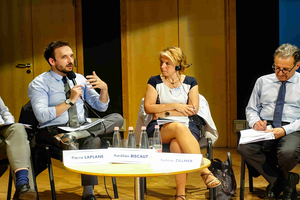News
Progress in the area of cross-border monitoring?
June 2022
Summary of the conference held on 24-25 May by CESCI, in partnership with the MOT and the French Institute in Budapest.
Statistics more often than not stop at the border and thus building comparable datasets which are essential for proper cross-border spatial planning is extremely difficult.
This is why CESCI together with its partners, the MOT and the French Institute in Budapest organised between 24-25th of May an international conference with the participation of several of the most estimeed experts of the topic to map out what tools are in place already and also what still needs to be jointly done to improve the spatial monitoring in the EU.
In particular, the challenges1 and initiatives regarding spatial monitoring carried out at local2, national3 and European4 level were discussed.
The European Commission’s DG REGIO presented its programme to support cross-border cooperation – in addition to Interreg – within the framework of the CBCRII pilot project funded by the European Parliament. This comprises work looking at the impacts of the measures taken on borders linked to the pandemic on cross-border regions5 and cross-border public services6; and upcoming work: setting up an online European platform for cross-border services, EGTCs and other cross-border structures, and solutions to cross-border obstacles7; and lastly, an experiment regarding co-development, cross-border spatial planning and multi-level governance.
The DG REGIO representative emphasised that this programme can only be implemented with the support of all of the players. Its ultimate goal is to contribute to the redesigning of the multi-level governance of the management of borders (as “lines” but also as “cross-border regions”) within the framework of the legislative processes embarked on by the EU8.
The pilot project carried out by the Commission will require the involvement of local and regional players in cross-border territories, but also governments and public technical assistance structures (such as the MOT, the AEBR and CESCI).
The presentations can now be viewed on the event’s website: click here.
1. By Philippe Voiry, Ambassador for Intergovernmental Commissions, Cooperation and Cross-Border Relations (FR) and the OECD.
2. By the Greater Region's Geographic Information System and ADEUS (Strasbourg Upper Rhine Urban Planning Agency).
3. By the BBSR (Bundesinstitut für Bau-Stadt- und Raumforschung) along Germany's borders; the MOT and the ANCT along France's borders.
4. By the European research programme ESPON.
5. Work currently being carried out by MOT and Politecnico di Milano.
6. Work currently being carried out by Spatial Foresight.
7. In particular the "b-solutions" implemented by the AEBR.
8. Legal instrument designed to overcome obstacles (ECBM); revision of the Schengen Code.

